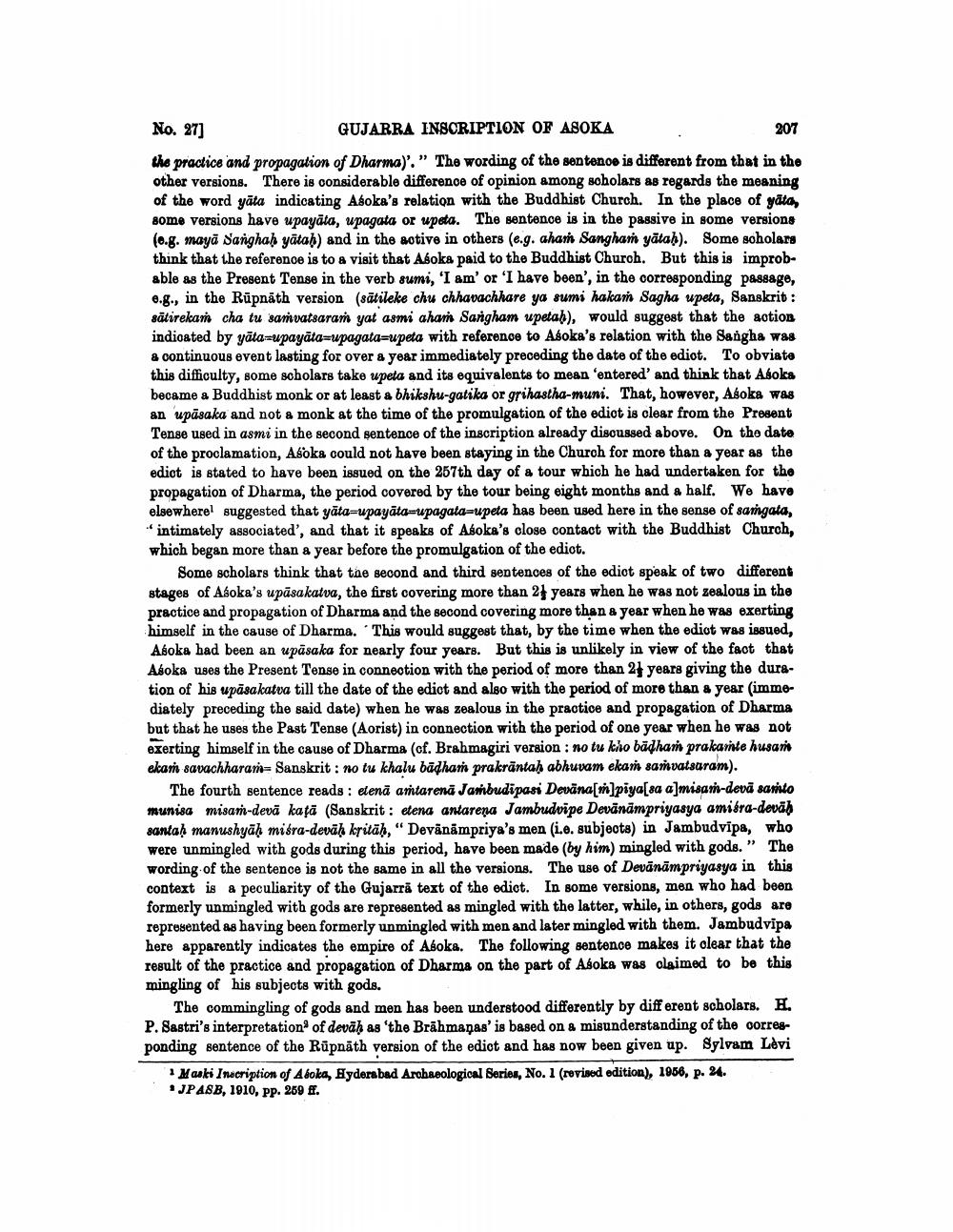________________
No. 27] GUJARRA INSCRIPTION OF ASOKA
207 the practice and propagation of Dharma)'.” The wording of the sentence is different from that in the other versions. There is considerable difference of opinion among soholars as regards the meaning of the word yāta indicating Asoka's relation with the Buddhist Church. In the place of gata, some versions have upayāta, upagata or upota. The sentence is in the passive in some versions (0.8. mayā Sanghah yātab) and in the active in others (e.g. ahan Sanghan yātah). Some scholars think that the reference is to a visit that Aboka paid to the Buddhist Church. But this is improbable as the Present Tense in the verb sumi, 'I am' or 'I have been', in the corresponding passage, e.g., in the Rūpnāth version (sātileke chu chhavachhare ya sumi hakaṁ Sagha upeta, Sanskrit : sātirekam cha tu samvatsarar yat asmi ahari Sangham upetab), would suggest that the actios indicated by yāta-upayāta upagata=upeta with reference to Asoka's relation with the Sangha was a continuous event lasting for over a year immediately preceding the date of the odiot. To obviato this difficulty, some scholars take upeta and its equivalents to mean 'entered' and think that Aboka became a Buddhist monk or at least a bhikshu-gatika or grihastha-muni. That, however, Asoka was an upāsaka and not a monk at the time of the promulgation of the edict is clear from the Present Tense used in asmi in the second sentence of the inscription already discussed above. On the date of the proclamation, Asoka could not have been staying in the Church for more than a year as the edict is stated to have been issued on the 257th day of a tour which he had undertaken for the propagation of Dharma, the period covered by the tour being eight months and a half. We have elsewherel suggested that yāta=upayāta=upagata=upeta has been used here in the sense of sangata,
intimately associated', and that it speaks of Asoka's close contact with the Buddhist Church, which began more than a year before the promulgation of the edict.
Some scholars think that the second and third sentences of the ediot speak of two different stages of Asoka's upāsakatva, the first covering more than 2 years when he was not zealous in the practice and propagation of Dharma and the second covering more than a year when he was exerting himself in the cause of Dharma. This would suggest that, by the time when the ediot was issued, Asoka had been an upāsaka for nearly four years. But this is unlikely in view of the fact that Aboka uses the Present Tense in connection with the period of more than 21 years giving the duration of his upāsakatva till the date of the edict and also with the period of more than a year (immediately preceding the said date) when he was zealous in the practice and propagation of Dharma but that he uses the Past Tense (Aorist) in connection with the period of one year when he was not exerting himself in the cause of Dharma (cf. Brahmagiri version : no tu kho būdham prakamte husar ekar savachharan-Sanskrit : no tu khalu bādhan prakrāntah abhuvam ekaṁ samvatsaram).
The fourth sentence reads : elenā amtarena Jambudipasi Devāna[mn]piya[sa a]misari-devā santo munisa misam-devā katā (Sanskrit : etena antarena Jambudvipe Devänāmpriyasya amisra-devāh santaḥ manushyāḥ misra-devāk kritāḥ, "Devānāmpriya's men (i.e. subjects) in Jambudvipa, who were unmingled with gods during this period, have been made (by him) mingled with gods." The wording of the sentence is not the same in all the versions. The use of Devānāmpriyasya in this context is a peculiarity of the Gujarra text of the edict. In some versions, men who had been formerly unmingled with gods are represented as mingled with the latter, while, in others, gods are represented as having been formerly unmingled with men and later mingled with them. Jambudvipa here apparently indicates the empire of Aboka. The following sentence makes it clear that the result of the practice and propagation of Dharms on the part of Asoka was claimed to be this mingling of his subjects with gods.
The commingling of gods and men has been understood differently by different scholars. H. P. Sastri's interpretation of devāh as 'the Brāhmaṇas' is based on a misunderstanding of the corresponding sentence of the Rūpnäth version of the edict and has now been given up. Sylvam Levi
Maski Inscription of Aboka, Hyderabad Archaeological Series, No. 1 (rovised edition), 1966, p. 24. • JPA8B, 1010, PP. 269 ff.




